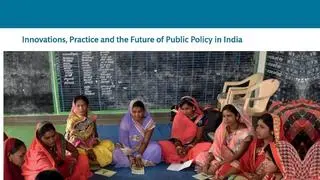About the book
Delhi, Agra, Fatehpur Sikri: Monuments, Cities and Connected Histories
Shashank Shekhar Sinha
Pan Macmillan India
299 pages; Rs 999 (Rs 427 online)
When you first lay your hands on a book with a title like Delhi, Agra, Fatehpur Sikri: Monuments, Cities and Connected Histories – the expectations aren’t too many. After all, there are so many books that one has read about these three cities and their monuments or heard so many tales around them that you wonder if you really need to invest time in yet another book. However, no sooner do you get past a few pages, you realise that this is a rare piece of work – captivating and full of rich details.
Interestingly, there is a 17-page prologue and a 68 pages introduction that set the context to this book. And it is here that you get hooked to a fascinating discourse in history of these three cities. The author, Shashank Shekhar Sinha, is an independent researcher and a ‘public historian’ who used to teach history at the University of Delhi.
In Delhi, Agra, Fatehpur Sikri , Sinha covers six UNESCO World Heritage Sites that these three cities are home to and packs in so many details and historical background that it leaves you wonderstruck.
One thing that stands out in the book is the manner in which Sinha takes you around these monuments. Not only does he pepper the narrative with little known tales and details – he demolishes a few myths too. For every single monument of the six that he covers in the book – he leaves the reader more informed, more intrigued and more attached to the monument and its historical significance. His deft handling of the myths and the controversies reflect a scholarly detachment as he puts forward all the possible angles and evidences that exist leaving the reader empowered to make a judgment.
Ironically, it is this richness of the evidence that makes judgment rather difficult and you can feel the author smiling between the sentences at the reader’s predicament. Take, for instance, his piece on the myths on the source of the Iron Pillar at Qutub Minar complex. Sinha tells you about all the claims made by various historians attributing it to Chandragupta II of the Gupta dynasty to the Tomar King Anangpal to the Slave Dynasty’s Iltutmish. He also offers some evidence as to why this pillar has not rusted even after 1600 years despite being made of iron. And then you catch the author gleefully stating that ‘the pillar is a curious alloy of myth, legend and history’.
Equally intriguing and captivating are the chapters on Humayun’s Tomb, Agra Fort, Fatehpur Sikri, Taj Mahal and Red Fort. Sinha looks at these heritage sites from their larger geographical, socio-cultural and historical context combining academic research from across disciplines such as history, archeology, architecture, etc., and he laces his factual discourse with tales and folklore drawn from oral history.
Aided with site maps and photographs the reader is virtually transported to these enchanting locales. For someone like me, who has been born and brought up in Delhi, with Red Fort as a backyard of my childhood home and Qutub Minar complex as the venue of every alternate picnic - one was not too sure if there is more to know about these places. But Delhi, Agra, Fatehpur Sikri catches you by the collar and takes you around these all too familiar sites once again, leaving you with a brand new perspective.
The result is that, enriched with this fascinating background and history, one would want to spend far more time at these six sites than one normally does.
Intriguingly, Delhi, Agra, Fatehpur Sikri begins with a four-page guide on ‘How To Read This Book’. If it was lack of conviction on the part of the publishers that readers will not stay on with the book and would want to jump across chapters – then it seems to be a big error of judgment. One reads the book as one would read a thriller – from start to finish! The only drawback is that the photographs are in black and white - which in today’s age and era are a dampener.
What led Shahjahan to leave Agra and why Delhi was chosen as the seat of the throne? How, in some popular folklore constructs, did the Iron Pillar give Dilli its name? How Akbar’s reverence to Sufi saints was a factor behind the choice of Fatehpur Sikri as the imperial capital? And how a shift in his religious temperament led him to desert it and opt for Agra? The answers to such posers are just a few of many enriching nuggets that this book will leave you with. If such stuff can leave you mesmerized even if the reader is not a student of history then let there be more of it. And if this is how ‘public historians’ can impact you then let there be more Sinhas.
(Giraj Sharma is a brand consultant. An out and out Delhi boy, he runs a tongue-in-cheek blog called State of Delhi)








Comments
Comments have to be in English, and in full sentences. They cannot be abusive or personal. Please abide by our community guidelines for posting your comments.
We have migrated to a new commenting platform. If you are already a registered user of TheHindu Businessline and logged in, you may continue to engage with our articles. If you do not have an account please register and login to post comments. Users can access their older comments by logging into their accounts on Vuukle.